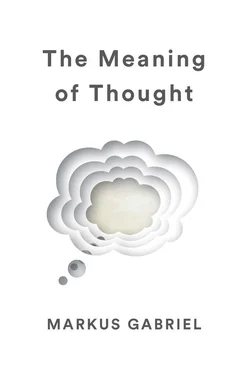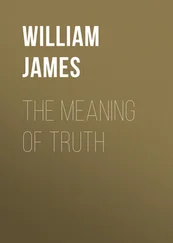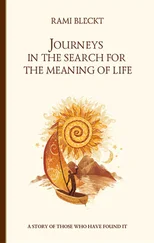The first key thesis, as I’ve already said, is that our thought is a sense. Besides the familiar sense modalities – which are hearing, sight, taste, smell and touch, but also the sense of balance and a few more besides – we have a sense of thought. I will expand this thesis into the nooscope thesis: our thought is a sense that we can use to scout out the infinite and then represent it in a variety of different ways – mathematically, for example. Our thinking is thus unlike our other senses: it is not restricted to our proximate environment but can – in the form of quantum mechanics, say – even refer to other universes or grasp the foundational mathematical structure of our own universe in the language of theoretical physics. Our nooscope therefore surpasses corporeal reality and connects us with an infinity of immaterial realities.
This thesis is directed against the currently popular idea that our mental apparatus consists merely of perceptions and cognitions, out of states triggered in us by the external world on the one hand and states that arise from the internal linkage of perceptions on the other. But it’s simply false to believe that an external consciousnessand mind-independent world first tickles our nervous system, triggering chains of internal processes, at the end of which stands an image that has nothing further to do with the external world. Our mental life is no hallucination arising within our skull. Rather, on account of our sense of thought, we are in contact with far more realities than we’d think at first glance.
This book does away with the foundational error of modern epistemology: the subject–object divide. This consists in the false notion that, as thinking subjects, we confront an alien reality, a world into which we don’t really fit. Hence the widespread impression in modernity either that we cannot know reality at all or that we can never know it even approximately as it is in itself. However, as thinking, perceiving creatures we do not face a reality that is somehow separated from us. Subject and object are not opposed parts of an overarching whole. Rather, we are part of reality, and our senses are media that act as contact points between the reality that we are and the reality that we are not. These media do not distort a reality that is fully independent of them. Instead, they themselves belong to the real, as interfaces or points of intersection. And thinking, exactly like all the other senses, is just such an interface.
Interfaces enable communication over various fields of sense. Take our visual experiences, for example. I can currently see a Berlusconi voodoo doll, which I bought in the shop of a Portuguese museum. I see the doll from my standpoint. I couldn’t take up this standpoint if I didn’t possess an intact brain, if I were currently sleeping, or if I no longer recalled the doll. But the fact that I can recognize the doll in the first place is also a component of my standpoint. And the real presence of the voodoo doll is just as essential for my perceptual mental state as my brain.
I perceive in colour. And I have a specific colour palette at my conscious disposal only because I am an animal whose colour receptors were selected over millions of years of evolution. The human sense of sight is an interface enabling communication between physical fields (containing light rays, for example, which can be measured and investigated by physics) and the field of my conscious experience (in which I can purchase and see voodoo dolls). Our visual sense and our subjective standpoint are not one jot less real than the light rays, the voodoo doll, and the elementary particles without which there wouldn’t be any voodoo dolls at all.
As we will see, the same goes for our thought. Thought is a real interface connecting us up with countless immaterial realities – numbers, justice, general elections, truth, facts and much more besides. Yet thought also stands in direct contact with material energetic systems, which is why we are able to think about these too.
In this context, a further thesis is that what we think (i.e. our thoughts) is not material. The view that there is not only a material energetic system, the physical cosmos, is what I call immaterialism. Thinking is the grasping of immaterial thoughts. Thoughts are neither brain states nor any form of information processing that we measure physically. Yet humans cannot have any thoughts without being living creatures who find themselves in certain brain states – or, more generally, in certain physiological states.
Combining these theses, we get to our second key thesis: biological externalism. Biological externalismmaintains that the expressions we use to describe and understand our thought processes are essentially related to something biological (see p. 141). With this thesis in place, I’ll argue that there can be no artificial intelligence in the generally accepted sense. Our modern data-processing systems, including of course the omnipresent internet, do not really think, because they lack consciousness. But this doesn’t make them any less dangerous or the debate surrounding digital transformation any less urgent.
We have to regain the sense of thought and defend it against the wild notion that our thinking is a computational process taking place within the cranial vault – a process of which we could, in principle, make an exact re-creation or simulation. Simulations of thoughts are just as much real thoughts as a Michelin map of France is identical with the territory it maps (see pp. 57ff.). Yet what we call AI is utterly real. Only it’s not intelligent – and that’s why it’s dangerous.
One of the underestimated sources of danger in our digital age is that our self-understanding as humans is oriented around a misleading model of thought. For, insofar as we believe that advanced data technology must automatically conquer the realm of human thought, we create a false self-image. In indulging this belief, we attack the very core of being human.
In every epoch that has witnessed technological breakthroughs, the idea has taken hold that our artefacts could someday take control. Animismis the belief that nature as a whole is ensouled. Today this belief is also called panpsychism. AI research, however, is an internal rather than an external attack on the human being: for it’s not just that our artefacts might attack us; instead, by propagating a false, essentially animistic picture of them, we attack ourselves.
Since time immemorial, the human has regarded its thought as something that comes to it from outside, be it from the gods, from the one God, or possibly from extra-terrestrials, as in films such as Stanley Kubrik’s 2001: A Space Odyssey (1968) or, more clumsily, Ridley Scott’s Prometheus (2012), which unambiguously depicts aliens as our creators. Thanks to layer upon layer of our culturalhistorical practices, we therefore find it easy to image that our own thought processes might also be found in non-living systems. But this is an unwarranted superstition and we need to overcome it. Many people today would be more willing to ascribe intelligence to a smartphone than to an octopus or a pigeon. But that is a mistake with fatal moral consequences – for humans, for our fellow creatures, and for the environment. It is therefore high time that we let ourselves be guided by realism rather than misguided by science fiction and that we re-establish contact with our human, all-too-human sense of thought. The first step is to recognize it as such.
1 * Words appearing in bold type appear in the Glossary at the end of the book.
2 1. In the main body of the text, I define bold expressions as precisely as possible. The definitions are also collected in a glossary at the end of the book to provide a clear overview of the most important concepts I’m working with.
Читать дальше










